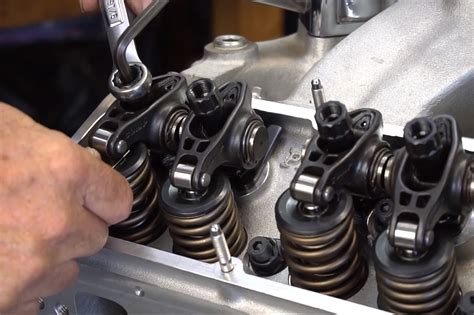350 Chevy: Prevent Engine Problems – Valve Adjustment
The legendary 350 cubic inch small-block Chevrolet engine, a workhorse of American automotive history, is known for its power and reliability. However, even this iconic engine requires regular maintenance to prevent potential problems. One crucial aspect often overlooked is valve adjustment. Properly adjusted valves are essential for optimal engine performance, fuel efficiency, and longevity. Neglecting this seemingly simple task can lead to costly repairs down the road. This article will delve into the importance of valve adjustment in your 350 Chevy and guide you through the process.
Why is Valve Adjustment Crucial for My 350 Chevy?
Valve adjustment ensures the proper clearance between the valve stem and the rocker arm. This clearance, known as valve lash or valve clearance, allows for thermal expansion and prevents damage to the valve train components. Incorrect valve lash can manifest in several ways:
- Reduced Engine Power: Too much lash (loose valves) prevents the valves from fully opening, restricting airflow and reducing power output.
- Poor Fuel Efficiency: Inefficient combustion due to improper valve timing directly impacts fuel consumption.
- Premature Wear: Excessive valve lash leads to increased wear on the camshaft lobes, rocker arms, and pushrods.
- Burnt Valves: Insufficient lash (tight valves) can cause valves to remain open too long, leading to overheating and burning.
- Engine Noise: Unusual ticking or tapping sounds often indicate a problem with valve adjustment.
How Often Should I Adjust the Valves on My 350 Chevy?
The frequency of valve adjustments depends on several factors, including the type of camshaft (hydraulic or solid lifter), the engine's operating conditions, and the overall condition of the engine. Generally, you should refer to your engine's maintenance schedule or consult a qualified mechanic.
Hydraulic Lifters: Engines equipped with hydraulic lifters (most common in stock 350 Chevys) typically require less frequent valve adjustments. Hydraulic lifters automatically adjust valve lash, but they can still wear over time and require attention. Check your owner's manual or a reputable service manual for recommended intervals, which often range from 30,000 to 60,000 miles.
Solid Lifters: Engines with solid lifters need more frequent valve adjustments, usually every 5,000 to 10,000 miles, or even more frequently depending on usage and performance modifications. This is because they rely on precise manual adjustment to maintain the correct valve lash.
What Tools Do I Need for Valve Adjustment?
Performing a valve adjustment requires precision and the right tools. Here’s what you’ll need:
- Feeler gauges: These are essential for measuring valve lash. A set covering the recommended clearance range for your engine is crucial.
- Wrench set: The appropriate size wrenches for your rocker arm adjusting nuts are necessary.
- Socket set: May be required depending on your rocker arm design.
- Torque wrench: This is important for accurately tightening the rocker arm nuts to the manufacturer's specifications.
- Valve spring compressor (if replacing valve seals or springs): While not always required for a simple adjustment, it's helpful to have it on hand if you find other issues during the process.
- Shop manual: A detailed shop manual specific to your year and model of 350 Chevy is invaluable. It will provide exact specifications and procedures.
How Do I Check and Adjust My 350 Chevy's Valves?
This process is best detailed in your specific engine's service manual, as procedures may vary slightly. Attempting this without adequate knowledge and tools can cause serious engine damage.
Important Note: This is a simplified overview. Always refer to a detailed repair manual for your specific engine before attempting this procedure. Improper adjustment can lead to engine damage.
Generally, the process involves:
- Preparing the Engine: Disconnect the battery, remove the valve covers, and ensure the engine is cool.
- Rotating the Engine: Use a wrench on the crankshaft to rotate the engine to the proper top dead center (TDC) position for each cylinder. Your service manual will provide this information.
- Measuring Valve Lash: Use feeler gauges to measure the clearance between the valve stem and the rocker arm for each valve (intake and exhaust).
- Adjusting Valve Lash: If the lash is outside the specified range, use the appropriate wrench to adjust the rocker arm nuts. Tighten or loosen the nut until the feeler gauge slides with slight resistance.
- Retorquing: Once the lash is adjusted correctly, retorque the nuts to the specified torque value.
What are the Common Problems I Might Encounter During Valve Adjustment?
- Incorrect Valve Lash Measurement: This is the most common mistake and can lead to engine problems. Carefully read your shop manual.
- Damaged Rocker Arms or Pushrods: Check for any signs of wear or damage before and during the adjustment.
- Stripped Threads: Be careful not to over-tighten the rocker arm nuts.
Can I Avoid Valve Adjustment Problems Altogether?
Regular maintenance is key. Using high-quality oil and ensuring your engine is properly lubricated minimizes wear on the valve train. Following the recommended maintenance intervals in your owner's manual and listening for any unusual engine noises can help catch problems early.
This guide provides a general overview of valve adjustment on a 350 Chevy engine. Remember that this is a complex procedure, and it's essential to consult a service manual and potentially a qualified mechanic if you're unsure. Proper valve adjustment is critical for maintaining the performance and longevity of your 350 Chevy engine. Regular maintenance will keep your engine running smoothly for years to come.

